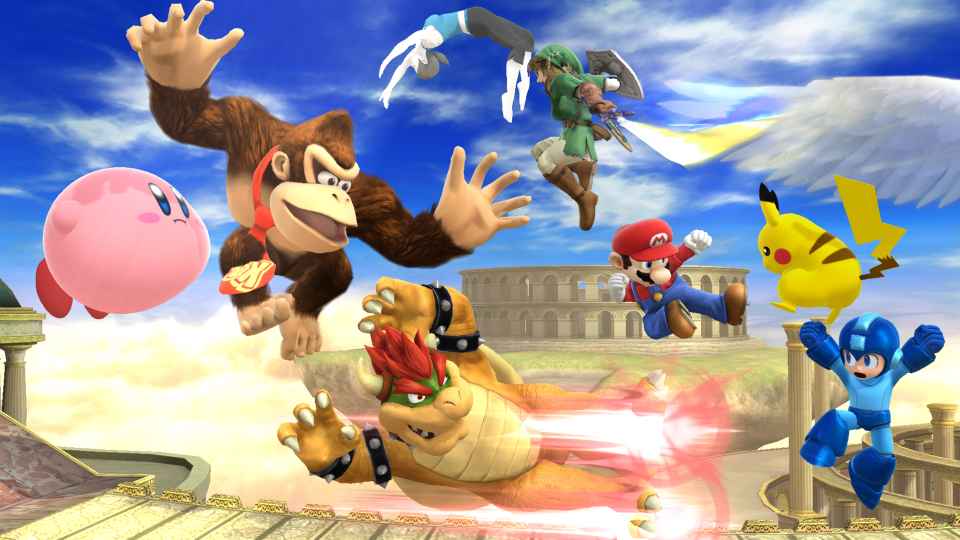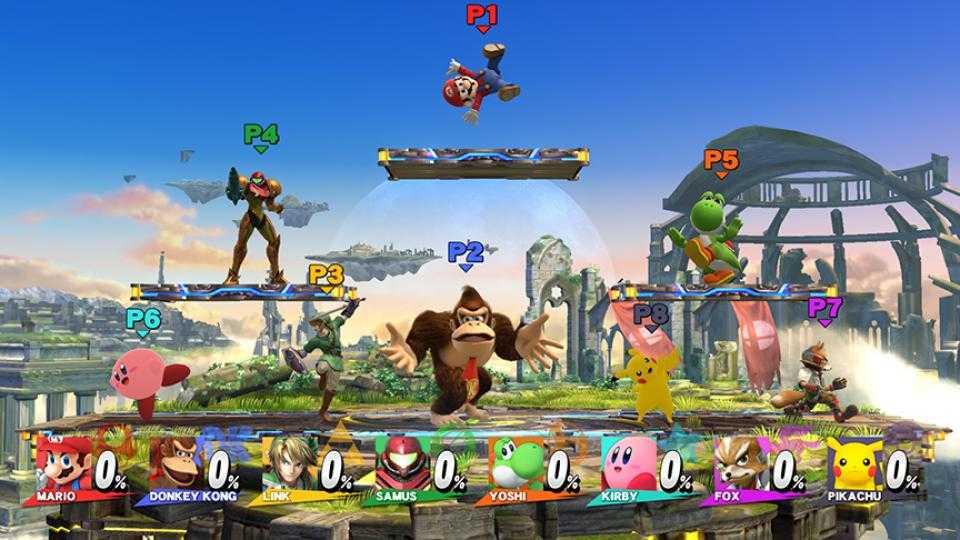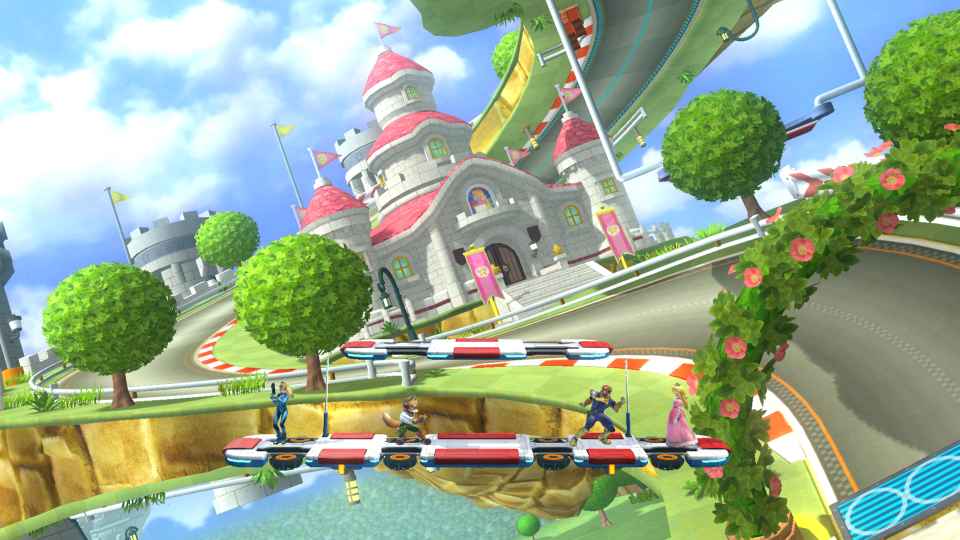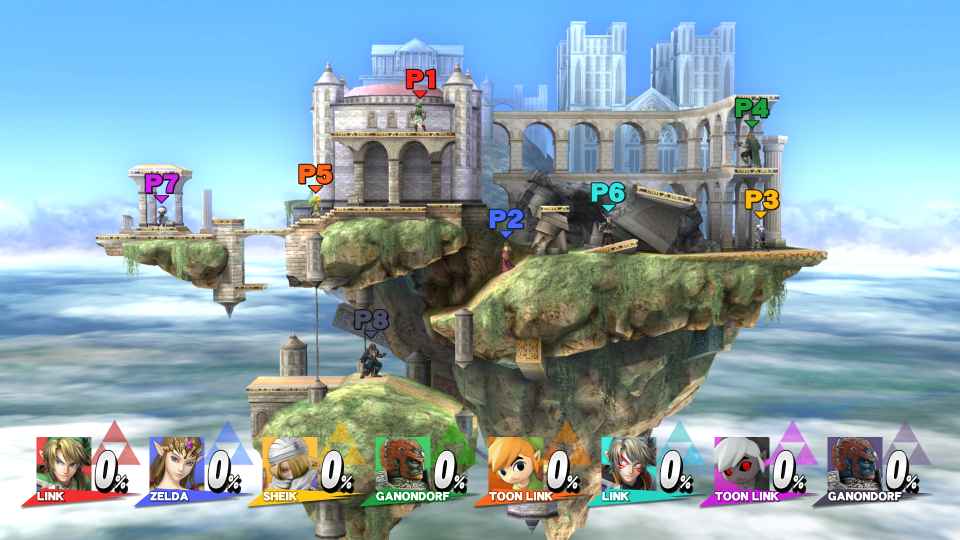As much as we loved Super Smash Bros for 3DS , Nintendo's all-star beat 'em up has always rightfully been a big screen, living room experience. While the 3DS version had very competent online and local multiplayer, it was ultimately a very single-player driven experience, something which the Wii U version rectifies almost immediately with its plethora of party modes and, most importantly, eight-player local Smash battles.
Luckily, getting lots of players together isn't quite as heavy on the wallet as local multiplayer used to be; the Wii U is compatible with almost every Nintendo controller under the sun, including the Wii Remote, Wii Classic Controller Pro and Wii U Pro Controller. You can even use your 3DS or 2DS if you own a copy of Super Smash Bros for 3DS, and anyone who picked up one of the now highly sought-after GameCube adapters can use their GameCube controllers as well.

Up to eight players can get in on Smash battles now, providing some brilliantly chaotic local multiplayer matches
Admittedly, controls are slightly hampered on the Wii Remote due to its lack of physical buttons, but nothing can replace a proper analogue stick when you're hammering out Smash attacks. The Circle Pad on the 3DS feels positively spongy by comparison, but we were still impressed by how well the Wii U simultaneously coped with all the different control schemes. The Wii U didn't drop the ball once when we got everyone playing together in the office, and while combat isn't quite as quick and slick as Super Smash Bros Melee on the GameCube, it certainly feels a lot faster than Brawl on the Wii.
In our eyes, the pace is just right, particularly as several characters have had their speed and weight rebalanced in the intervening years. Fox, for instance, is still as fast as ever, but the weight of bulky fighters such as Bowser, Ike and Donkey Kong feels much more pronounced here, helping to create a more marked difference between its ever-growing cast of characters. This is important when you've got 52 to choose from, particularly when some of them are almost move-for-move clones of each other.
Happily, the customisation options that we loved in the 3DS version are back in full force for Smash on Wii U, allowing you to customise your play style even further. As well as swapping out whole special moves, you can alter your chosen fighter's speed, strength and defence using badges that are won through other game modes. There's a huge number to choose from, and the same rules apply to both your Mii characters and any Amiibo figures you fight with, although we couldn't test out the latter as we weren't sent any for review.

The standard Battlefield stage can get quite crowded with eight players, but there's also an extra large version to duke it out on as well
Online play was a bit hit and miss in our experience, as we had hardly any lag when playing with friends, but other matches against strangers were near unplayable. Still, matches began quickly and the wide range of modes offers something for casual and competitive players alike. It's a shame that voice chat is prohibited during matches, but this is probably for the best as the Wii U GamePad's tinny speaker was so crackly when we tried it over the menu screens that we had a hard time understanding what was being said.
Our main disappointment with Smash Bros for Wii U, though, is its heavy reliance on retro stages to bulk out its arena offering. The 3DS version had its fair share of older stages as well, but there were also plenty of others that made great use of the console's handheld source material to create rich and inventive fighting environments. The Wii U version, on the other hand, doesn't feel half as creative, as many are simply static platforms with fancy moving backgrounds.

Mario Circuit makes clever use of Mario Kart 8's twisty tracks to create temporary ceilings
It's the same trap that many of Brawl's stages fell into, but there are a select few that make more of an effort, employing excellent riffs on their respective games to help liven things up. Mario Circuit, for example, plays with Mario Kart 8's anti-gravity courses brilliantly, as sections of the track will periodically form an impromptu ceiling to prevent launches as the stages spins round different parts of the circuit.
Star Fox's Orbital Gate Assault is another favourite, as this sees players fight on the back of Arwings, the Great Fox, and a whole host of other ships that are continually barrel-rolling in and out of the field, shooting lasers and firing bombs and even exploding altogether. It's one of the grandest spectacles the game has, but when you've also got a choice of Star Fox's decidedly less exciting Lylat Cruise from Brawl right next to it, we have to wonder whether that space couldn't have been filled with something more interesting.
We suspect this is because the Wii U has, admittedly, a much smaller library of games on which to draw from compared to the 3DS. That said, we were surprised to see a stage from the forthcoming Yoshi's Woolly World which is due out next year, though its presence can't help but suggest that developers Sora Ltd and Bandai Namco were expecting it to be out by now.

Hyrule Temple first appeared in Melee on the GameCube, but it's arguably a much better fit for Smash Bros on the Wii U
Of course, trying to accommodate eight players presents a distinct problem for older Smash stages, as most of these were designed with a maximum of four fighters in mind. This means that several stages are off-limits when you're playing with five or more characters, but the extra large ones that are available offer a great mix of intense, up-close chaos and roomy luxury. Hyrule Temple from Melee, for instance, really comes into its own as an eight-player stage, as its huge size in previous games always felt like it was spreading the action a little too thinly to make it a truly great arena.
